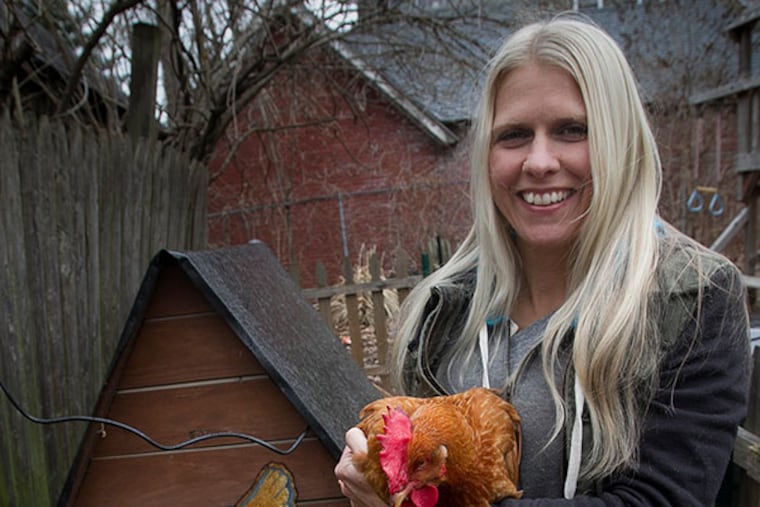Top Cook: Counting her chickens - and eggs
Overbrook Farms Marianne Morrison has an eggselent reason for keeping chickens in her back yard.

THE EGG TAKES center stage at Passover and Easter celebrations this week in many households. Thanks to Sarah, Eglantine and Miss Lips, however, every day's a celebration of the egg for Marianne Morrison.
Morrison raises backyard chickens. Three to be exact. Sarah and Miss Lips are Red Star breed; Eglantine is an Orpington. Depending on the time of year, but especially in the spring and summer, each hen can be counted on to produce an egg or two a day.
"I learned most of what I know when I worked as a zookeeper in the bird department at the Philadelphia Zoo," said Morrison. "One of the tasks I did was teach chickens how to recognize color for demonstrations in the Children's Zoo. You'd be surprised how they can learn trained behavior."
You also might be surprised to know there's a law against raising chickens in Philadelphia on properties of less than three acres, but that hasn't stopped the practice.
"There's actually a big push to legalize it," Morrison said. The advocacy group Philadelphia Backyard Chickens has 350 members on its Facebook page.
Morrison also teaches classes on raising chickens, and the fundamentals are fairly basic. You'll need a coop about the size of a doghouse, and a 5-by-12-foot run.
Contrary to common thought, you do not need a rooster, though you do need to be up with the sun to let the birds out, feed and water them, and clean the coop.
A locavore's delight
Eggs top the list for any cook interested in locally produced food. Freshly laid eggs compare to factory eggs the way a homegrown tomato compares to one trucked in to the supermarket.
"You notice the difference immediately when you crack the egg open," Morrison said. "The texture of back-yard eggs is one of the features, and the color of the yolk is also much richer, too."
Morrison enjoys cooking with her two children, Stella, 9, and Phoenix, 3, whether their dishes include eggs or not. Her favorite cuisine is Indian, and she often reaches for The Art of Indian Vegetarian Cooking by Yamuna Devi.
The book has no egg recipes, but it did provide Morrison with her favorite ingredient for scrambled eggs - ghee, or clarified butter, often used in Indian cookery.
Ghee is made by slowly heating butter until the milk solids separate and fall to the bottom. The remaining liquid is simmered until the moisture is cooked off and it becomes a flavorful cooking oil.
You can make your own or purchase it from specialty food stores such as Gita Nagari Yoga Farm in rural Port Royal, Pa., where Morrison buys hers.
Another trick to Morrison's scrambled eggs is her favorite kitchen tool, a wooden spoon with an angled edge.
"I know that sounds picky, but it really is the perfect shape for scraping the eggs into curds," Morrison said.
The family's back-yard eggs also find their way into pancakes and baked goods. The size of the egg (small, medium or large) and its color depend on the breed of chicken. Taste isn't affected by size or color.
"Surprisingly, the color of the hen's earlobe will indicate what color egg she will lay," said Morrison. "At Easter, the Araucana breed is very popular because it lays pretty blue to bluish-green colored eggs."
Morrison never has to buy eggs, but for those who do, she recommends fresh, free-range varieties, because the health of the hen determines an egg's flavor.
Morrison swears by the technique below to make hard-boiled eggs that have a well-textured white that isn't rubbery and a yellow yolk that is cooked through but creamy. To make sure the shells peel off easily, use eggs that are at least a week old.
The versatile hard-boiled egg can be served warm right from the pot with salt, pepper and butter, or used cold in salads and deviled eggs or mashed with mayonnaise for a sandwich filling. Once chilled, hard-boiled eggs are also ready to dye for Easter.
PERFECT HARD-BOILED EGGS
Place 6 to 12 room-temperature eggs in a heavy pot and cover with cold water. Over medium-high heat, bring water to a boil and boil gently for two minutes. Turn off the heat or remove pot from electric burner and cover with a lid.
Steam for 15 to 20 minutes.
Larger eggs or eggs taken directly from the refrigerator will need more time. Remove eggs to an ice-water bath to cool, then refrigerate till using.
Morrison recalls her mother making scrambled eggs in a cast-iron pan almost every morning. Morrison does the same but with one change - she uses ghee, not butter. For a special holiday brunch, Morrison recommends adding minced fresh rosemary or basil to the mixture. She serves scrambled eggs with black beans and corn tortillas.
EVERYDAY SCRAMBLED EGGS
6 eggs
1 tablespoon ghee
Salt and pepper
Crack eggs into medium bowl and beat with a fork until frothy. Set aside.
Melt ghee in a 10-inch skillet over medium heat.
Pour the eggs into the pan and allow to set slightly. Using a wooden spoon, slowly stir the eggs in a circle, forming large curds.
When the eggs are still slightly wet, remove from the pan. The eggs will continue to cook from residual heat so be careful not to overcook. Add salt and pepper to taste. Serves 3 to 4.